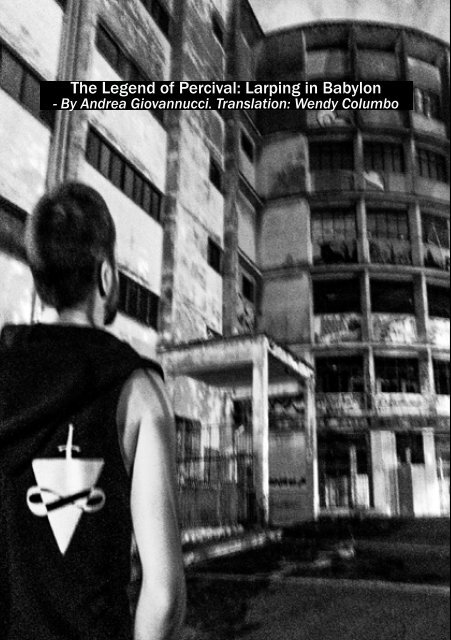nordiclarpyearbook2015
nordiclarpyearbook2015
nordiclarpyearbook2015
You also want an ePaper? Increase the reach of your titles
YUMPU automatically turns print PDFs into web optimized ePapers that Google loves.
The Legend of Percival: Larping in Babylon<br />
- By Andrea Giovannucci. Translation: Wendy Columbo<br />
In September 2015, in the city of Rome, the<br />
Chaos League organized The Legend of<br />
Percival (La leggenda di Parsifal); a pervasive<br />
larp which cannibalised reality for a few<br />
days by asking its players to play the role of<br />
outcasts in search of their own physical and<br />
mental place: A search conducted within<br />
and without the self. Set in modern times<br />
and inspired by the works of Terry Gilliam<br />
(The Fisher King, 1991), Jim Jarmusch<br />
(Ghost Dog, 1999) and Alan Moore (V for<br />
Vendetta, 1982), the event was designed to<br />
delve into the concepts of marginality and<br />
morality.<br />
The characters played in The Legend of<br />
Percival all shared a painful personal history<br />
and were persuaded to be the moral heirs of<br />
the legendary knight Percival. Their attempt<br />
was to establish a new community - the reborn<br />
Camelot - on values such as mutuality,<br />
moderation and strict adherence to the<br />
inflexible moral code of medieval knights.<br />
Plunged into the throbbing heart of a chaotic<br />
Rome, they struggled against the annihilation<br />
of humanity.<br />
Needless to say, the underlying objective of<br />
this larp was to stimulate an unbiased debate<br />
about modern society - overwhelmed<br />
by individualistic views and interested only<br />
in the accumulation of superfluous objects<br />
- through the fictional expedient of larp.<br />
The style of play was 360º degrees illusion,<br />
without interruption and without use of<br />
meta-techniques.<br />
w<br />
Collaborative writing<br />
Before actually playing, participants created<br />
their characters under the guidance and<br />
supervision of the organisers. In outlining<br />
their personal traits, players were asked to<br />
give special attention to the construction of<br />
what was labelled the “pillar collapse”. This<br />
meant a traumatic event supposed to be the<br />
starting point of a death-rebirth process<br />
for each character. In layman’s terms, the<br />
“pillar collapse” could be represented by a<br />
bereavement in one’s family or by disturbing<br />
experiences able to make the characters<br />
question everything in which they firmly<br />
believed, able to shake their ideas and their<br />
way of life.<br />
Simultaneously, players were asked to begin<br />
to follow a training course, which would put<br />
them in an exact mental and physical state<br />
to face the larp properly. Participants were<br />
assigned meditation and breathing exercises<br />
(partly borrowed from the Zen tradition),<br />
which were to be performed on a daily basis<br />
for two weeks before the beginning of<br />
the game. For example, some of the assignments<br />
were based on selective auditory<br />
drills of self-listening and surrounding environment<br />
listening, in order to trigger an<br />
improved mastering of one’s interior space.<br />
The final goal of such training was to prepare<br />
players to the rhythms and concepts<br />
they would face during the live event, to reduce<br />
the impact with a reality very different<br />
from their everyday life.<br />
The third phase of the “diffused game” (a<br />
pre-game stage which took place entirely<br />
online) introduced characters to the inner<br />
workings of the game.<br />
22 23


